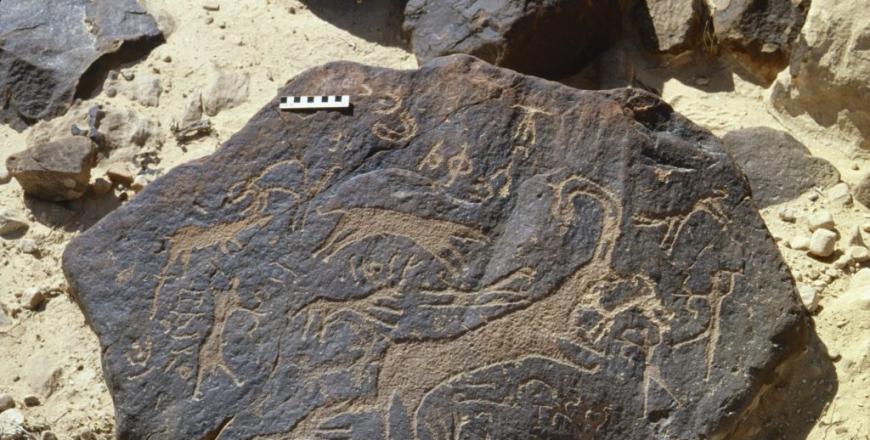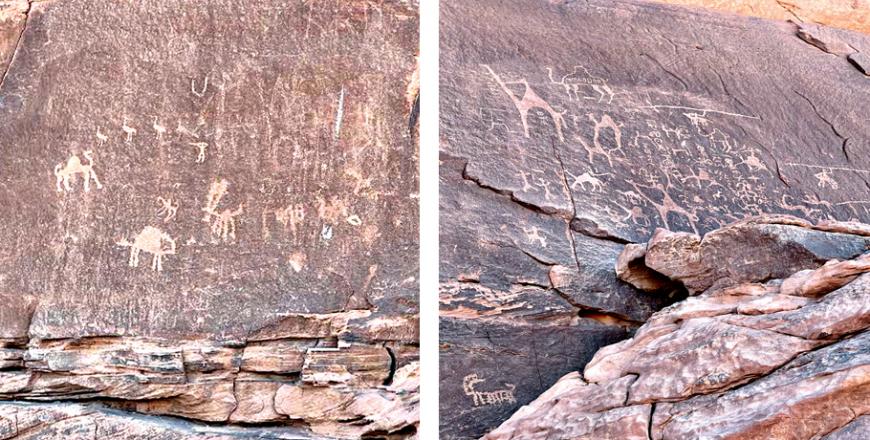You are here
Inscriptions of Wadi Rum: Studying ancient Nomadic life
By Saeb Rawashdeh - Jun 07,2024 - Last updated at Jun 07,2024

A petroglyph found in Wadi Rum (Photo courtesy of ACOR)
AMMAN – The late Australian scholar from The University of Sydney, William Jobling, meticulously studied inscriptions in the Wadi Rum back in 1980 and 1981. He then discovered some stone structure, flint tools, ceramic assemblages, rock drawings and Thamudic inscriptions. One of the inscriptions found by Jobling ended up in the Amman Museum, while many results of his research remained unpublished due to his premature death.
However, in 2014, Khaled Tarawneh, from the Department of Antiquities, and a French epigraphist, Jerome Norris, from the University de Loraine, recorded 36 Ancient North Arabian graffiti.
Norris said about the desert: “Flanked by two linear arrangements of sandstone massifs, it is about 2 kilometres wide and stretches approximately 16 kilometres from the village of Ṣaliḥiyya towards the Jabal Khamıla. The highest point bordering the valley is that of Jabal Ramman which rises to an altitude of 1404 metres. Its vegetation is typical of that of the Ḥisma Desert, globally characterised by the association of acacia trees with small bushes of the Haloxylon and Retama raetam species.”
Since the late 1990’s, the Wadi has become a protected reserve into which the Arabian oryx and Nubian ibex were reintroduced, two species which are often a motif in Arabian rock art.
Very few petroglyphs have been recorded during 2014 survey on this side of the valley, which is mainly dominated by granitic blocks and does not have good rocky surfaces for carving, and Norris suggested that Wadi Rum is more likely to be the place where AMJ 2 comes from.
“This tributary of Wadi Ramman contains the remains of an ancient installation around which many fragments of Roman pottery have been found,” Norris said, adding that it also has two petroglyph panels packed with several animal figures,
Furthermore, it is precisely on Jabal Maḥlaba that the team located AMJ 1, showing that Jobling was active in this area.
“Although it cannot be confirmed, the provenance of AMJ 2 from Wadi Rum thus appears probable and despite its brevity, AMJ 2 is of great interest in the study of the language and history of the nomads who lived between southern Transjordan and northern Arabia in antiquity,” Norris underlined, adding that it completes their knowledge of Hismaic grammar in providing the first example of the feminine form of the relative pronoun, ḏt, a form comparable to the Arabic ḏat.
It introduces a new lineage name, Glmt, and opens up a discussion about the relationship of female nomads with the production of inscriptions, he continued, noting that the rarity of women’s texts written in the Hismaic, Safaitic and Thamudic B, C, D scripts is a complicated issue which is intimately related to the function of literacy among the North Arabian nomads.
“While it certainly had many complex causes, probably different throughout the ages and tribes, one may suggest that a specific organisation of the nomadic life between men and women could well have been at least one of these reasons; for the men more opportunities arose during their daily activities to create inscriptions than for their wives,” Norris underlined, adding that women produced texts identical in their structure to those of the men.
“They identified themselves by their genealogy and tribal group with no reference to their husbands,” Norris said.
Related Articles
AMMAN — Wadi Rum is a desert on the southern part of Jordan also known the Valley of Moon.
AMMAN — William Jobling, the late professor at the University of Sydney, was the head of the Aqaba-Maan Archaeological and Epigraphic Survey
AMMAN — The 12,000 years of human occupation in the Arabian Peninsula are illustrated through the diverse markings left by various civilisat













